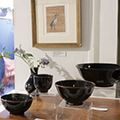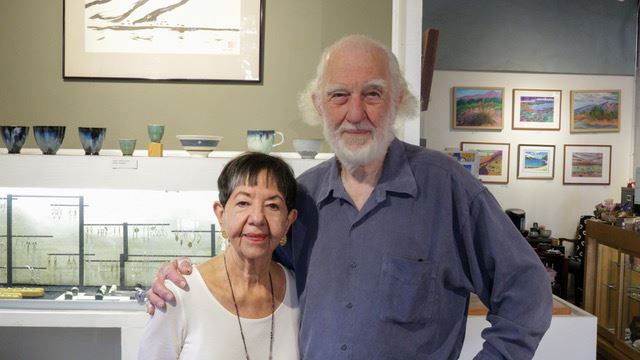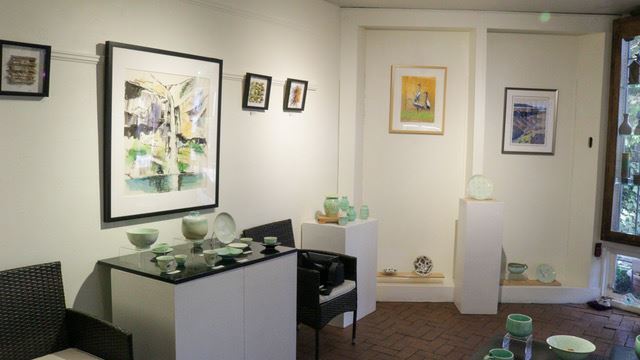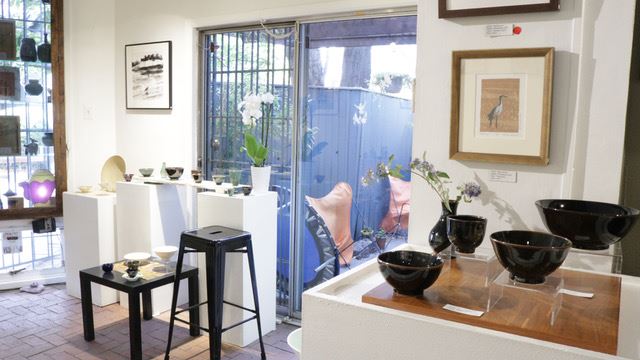
Gary and Valerie Tibbetts of Weyrich Gallery are retiring, and will be closing the gallery January 30, 2022 after almost 40 years enriching the community with their array of fine art. Their support of potters and ceramic artists has been unparalleled. Grateful for the time given by Valerie and Gary for this interview --- this is “Part One,” --- “Part Two” will be published at a later date.
From their website:
Weyrich Gallery, owned by Valerie and Gary Tibbetts, is a special place. Intuition is the determining factor in the harmony the Tibbetts have orchestrated in their small space whose inspiration is on a grand scale. The thoughtful visitor will soon realize the high level of craftsmanship reflected in the work on display and also the sense that gallery artists seem to have an affinity with each other.
The Weyrich Gallery is full of educational and artistic products and services that bring harmony into one’s hectic life. We offer a creative environment featuring exquisite jewelry, paintings, acrylic, pastels, and prints. Also mixed media, glass, metal, wood, clay, fiber, wood block prints, hand colored photography, monotypes, and limited-edition prints.
In a follow-up conversation after the November 15th interview, Valerie told the story of how she became enthralled by a place they visited in Latin America (their mode of transport was hitchhiking). The vision she gained there would give fruit to starting the gallery, and lead them to name it a “Rare Vision” gallery. A vision they have been dedicated to ever since.
The Slip Trail: What do you think of this warm weather?
Valerie: Ha! We should be out hiking!
Gary: It’s scary. What’s the summer going to be like?

PHOTO CREDIT: Leonard Baca, November 2021
TST: Here is that first question I sent. You have shown ceramists/potters from New Mexico as well as potters from across the country in your gallery. Talk about the importance of ceramics and clay to your gallery.
Valerie: Well, I’m just going to start from the beginning. In 1982-83, we opened a “rare vision” type of gallery, our focus on fine craft and fine art, mixed media, ceramics, paintings, and prints. My background is in fine art and metal work design. In 1973 my study of art and metal work began. I studied fine art at the University of New Mexico, and lived and studied arts and metals work at the Art Institute in Córdoba, Spain for 9 months, in 1974-75. Gary graduated from UNM with a degree in anthropology, and had studied ceramics in Sydney, Australia in 1966. And he will give you a little bit of a connection leading up to that answer about his experience with clay. In 1989, Jim Srubek, a professor at the university in the College of Education, came to our gallery and asked to do a show, I think it was called “Legacy in Porcelain,” with his work and the students of the Arita Method of Porcelain program. We had a very successful show, and continued to exhibit ceramics from University of New Mexico. The gallery continued to feature works by UNM students and faculty after Prof. Srubek retired in 2001, until 2021.
Gary: The first show was 1989 although we are not certain of the date.
Valerie: We had been exhibiting tea bowls, and really didn’t have much knowledge about Chado / Japanese Tea Ceremony, so, when Kathy Cyman came on board in 2001, I asked her if there was ever a teacher, I would love to know more about tea bowls, and to start studying about Chado. And that led me and Gary to a teacher and to many other accredited teachers in the U.S.A., many would come and speak/tour to ABQ and Santa Fe. The school of Japanese Tea Ceremony is called Urasenke. We started in 2006. Chado New Mexico group connected us to many different ceramic artists in N.M. and nationwide. And so, Gary and I would go out to the west coast to San Francisco and stay there, cause that’s where the North American headquarters for Urasenke is, at Green Gulch Farm north of San Francisco. And there’s a tea house there, there was one also here in Santa Fe that we were lucky enough to drink tea in also. This was the catalyst that changed our outlook in ceramics and clay, and to present it at the gallery as fine art, not fine craft. Because in the East, ceramics back in Japan, it’s considered a fine art. I’d been to Japan twice, and was exposed to ceramics, Raku, Hagi, in the different prefectures in Japan, Bizen and Karatsu, and how again ceramics in the East is considered a fine art. The study of Tea is a very deep and moving meditation that opens the senses of the physical body and also really connects with the present moment. It is very sensual: smells, touch, sound, seeing, listening, taste. And again, the Japanese Tea ceremony has the 4 principles: wa - harmony, kei - respect, sei - purity, jaku- tranquility. So, this really started Gary and I to understand more about clay and ceramics by holding tea bowls. Then we had to start learning more about glazes, the rim of the bowl, the foot rims, the clays, the shapes of the tea bowl. Again, Raku - considered the crème de la crème, Hagi, and Karatsu ware. This really changes our eye. The subtleties of holding the tea bowl in our hands and mixing tea in the vessel with the whisk and preparing tea, but also during the ceremony, before drinking, you make an offering, called kanche, honoring the tea, the potter, the people that made all of the utensils, past and present, was important. The shape of the bowl, the front, maybe where the glaze has hit the bowl. I think what really happened is we were taught, not just us, we were taught the pure essence of the bowl. And again, really moving into the present moment, I think that’s why we were willing to sit you know in these strange positions sometimes [both chuckle]. In my mind, the Tea connects with the kokaro, which is the Japanese term for heart-mind connection. So here we started opening the heart area, not really intellectualizing about the glaze or the form, but we were moving into learning about the essence of what you were holding in your hand. So that’s what I feel was my story of how we began, the answer to your question.
TST: Describe a potter your gallery has represented, sharing an anecdote.
Valerie: One time at my tea class, which is called a tamae in Japanese, I was using a water container with the form called mizusachi, that a potter Willi Singleton had made. I was moved by the form, the glaze, the design. I didn’t know he had studied in Japan 6 years. And dug his own clay and made his own glazes. I was then introduced to anagama, the wood-firing kiln by Willi, the potter from Hawk Mountain, Pennsylvania, and he taught us about his process of “Slow Clay,” like “Slow Food.” He was a teaching potter at Lama Foundation in the Sangre de Cristo mountains, which was started by Millie Johnstone. She’s an important figure because she’s the one that brought Urasenke to Lama Foundation in 1970. That’s where a lot of our teachers were coming from. Then we were introduced to different conferences, one was called Tea Beyond Japan, where there were new teachers, new ceramics, and artists, a circle of artists, not only we were exposed to local potters like Kathy Cyman, Michael Thornton, Michael Prokos, or some of our Native American potters that we had, we were also then introduced to people like Rob Barnard, Judith Duff, Jack Troy. And that also broadened our awareness. I continued to see that it really happened, even though I had been to Japan twice, and introduced to it while I was there, I think it was the actualization of holding the vessel, and really being taught how you look at them. And that too, as I said, the intellectual mind, that really kind of heart-felt … what was the essence of the vessel that you were holding. We’re such a throw-away society, and we’re moving at such a fast rate, that even I know for artists, they’re not being able to center, you know, so that they can quiet themselves and kind of get grounded.

PHOTO CREDIT: Leonard Baca, November 2021
TST: Didn’t you also hold seminars and workshops there at the gallery?
Gary: Yes, we had the classes in tea ceremony, but of course we also had openings throughout that whole period, that went along with it.
Valerie: Oh yes, many different times, yes. We did classes, as Gary was saying, in the loft, for I think two years, where our teachers would teach the pottery, and offered the tea room, but yes, we have done different exhibits with having our potters from NM come, and see the work of four students as well as other visiting ceramicists. Sometimes if we had an exhibit opening before that, what we would do was to bring the tatami mat out, then upstairs, we would create as a tea room, maybe we could only sit six people at a time. Then some of the members of the NM Potters group would come down because some of them lived in Santa Fe or Taos. Then they would talk about how you would move the bowl, and how you look at the subtleties of it. And sometimes the “Slow Clay” potter Willi Singleton, I think we had 10 shows with him, would always do a lecture about his process and a lot of potters would come to that. And sometimes he would go and do a teaching at UNM with Kathy Cyman’s class. When you know about glazes, when you know about shapes, and then developing that eye that you’re talking about, being exposed to shows and the things people do during the ceremonies --- when one starts developing that, one starts seeing things differently.
TST: Describe a learning experience you had with clay, and share about pottery you have made yourself.
Valerie: Part of Chado New Mexico arranged for people to visit different clay artists. Betsy Williams was a member of that. Betsy offered to do a class and she showed me how to throw a tea bowl. For me it was most humbling to get on a wheel and center, to knead the clay and all that. I left thinking, “This is hard work these people are doing!” I know a lot of the artists they say the clay, what they are doing, is valuable. Betsy says this helps her stay focused and centered. But Gary’s the one who has experience doing clay. more than I have. Gary, he’s a potter. When he looks at a potter’s cup, he immediately goes to the handle to see how the hand fits it, and also, he’ll put that cup to his lips.
Gary: The cup and the feel is so important, and the same with the Chawan [tea ware], which of course started out to be a Korean rice bowl, that were incorporated by the early people of Tea, when they got away from Chinese objects. The thought of it was being the epitome of what they were using, given to more wabi and more fundamental pieces of the tea- of more Japanese pieces. I was lucky enough to be introduced to pottery work in Sydney, Australia. I had a great teacher whose name was Ivan McMeekin, and he worked with Bernard Leach in St. Ives in his early days. And he was a friend of Hamada who came to the University of New South Wales and lectured and looked at what he was doing there. I was just very fortunate to be introduced to clay by using a kick wheel, and of course trying to make a cylinder out of a pound of clay, or tea bowl. I was just a beginner, just enough to give me a feel for what’s involved in pottery, in clay, in the work, and an appreciation of the work.
TST: Gary, your teacher had direct connections with Shoji Hamada and Bernard Leach. Did you meet either of them?
Gary: No. Ivan McMeekin was a great teacher and I was very fortunate to have some time with him. Some of his pottery was inspired by the Song Dynasty China stoneware that was made for the common people 1000 AD.
Valerie: with the celadon glaze ---
Gary: Celadon glaze, Ivan McMeekin loved that.
TST: Was there a museum there, a collection of Song Dynasty pottery?
Gary: Not there, but in the Philippines, we saw a great collection. In the Song Dynasty time, the Chinese and the Filipinos were trading with each other so you find lots of good Song Dynasty work in the Philippines.
TST: Very good to hear your teacher Ivan loved that. Not the ornate, painted with gold, that you’re saying the Japanese got away from and started to appreciate wabi, the style of their own pottery.
Gary: Yeah, they were using things in tea ceremony that were not only ceramics, but metal as I recall, and the Japanese in their early tea ceremony were using lots of Chinese stuff, but then they got to their own stuff.
Valerie: and Rikyu.
Gary: Yeah, Rikyu, the founder of that school.
Valerie: Rikyu, the founder of Urasenke. He was the one then that really brough nature into the tea room. It was more austere, not decorative, just like Gary was saying.
TST: Any more to add about experiences with clay?
Gary: A memory of Australia years ago, from when I was in New Guinea … Under a house on poles was a woman with her thumb up in the air and a lump of clay on the top of it. She was opening that lump of clay on her thumb, she was centering and opening it up to make something, I assume a bowl. But I will never forget that image of that lady, and God, there are so many ways to do clay!
Valerie: We aren’t as in touch with our bodies to know what we can really do with them that was the thing I thought about, oh my God, look at that! I think we underestimate the potential.
Gary: That is just something that has been in my mind for many years.
End of Part 1 --- to be continued …

PHOTO CREDIT: Leonard Baca, November 2021


